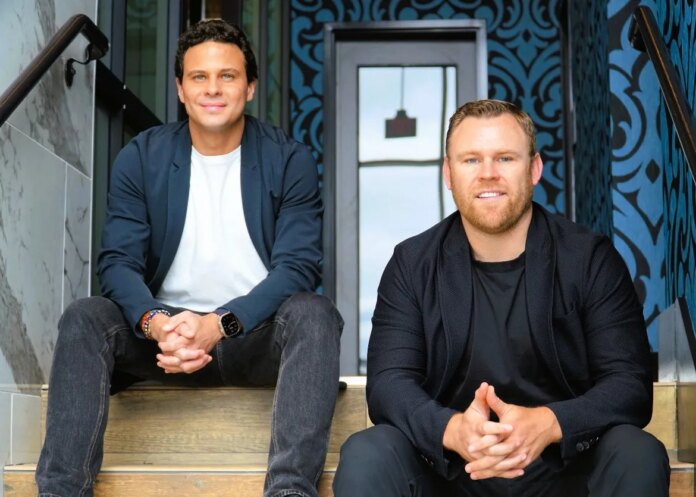It’s been almost a decade since Omar Darwazah and Kyle Hendrick launched AAF Management and its first fund of $25 million in 2017.
Rather than racing to dramatically increase their assets under management like many funds have in recent years, the partners have intentionally kept their fund sizes small, even as their reputation and returns have grown.
Their latest vehicle — a $55 million early-stage hybrid fund, dubbed the Axis Fund, that recently closed — brings the Washington-based venture firm’s total assets to roughly $250 million across four funds. The firm raised a $39 million Fund II in 2021 and a $32 million fund-of-funds investment vehicle in 2017 for a select group of its limited partners.
“Running a $50 million fund is very different from running a $500 million fund,” general partner Darwazah said in an interview with TechCrunch. “We’ve seen that naturally large fund sizes can disrupt GP-LP alignment as it becomes a function of management-fee generation versus carried-interest generation, and that’s not a game we want to play.”
Unlike typical VC firms that invest directly into startups, AAF is adopting elements of a fund-of-funds model where it invests part of its capital into a portfolio of emerging funds in addition to backing startups.
With this fourth fund, AAF plans to invest in emerging managers’ first or second funds (typically under $50 million) and their most promising portfolio companies from pre-seed to pre-IPO, the partners said.
The firm is allocating about 80% of its capital to startups and 20% to emerging funds, blending the two into what it calls a “one-stop capital-formation partner” for founders and fund managers alike.
Techcrunch event
San Francisco
|
October 27-29, 2025
So far, the Axis Fund has backed 25 pre-seed and seed-stage venture funds, along with five direct bets on early-stage and growth startups.
“We’ve found that the richest dataset of private-market companies at the earliest stages of their formation over the past decade is accessed only through LP checks in emerging managers,” said Hendrick, the firm’s other general partner.
This dual fund type strategy has granted AAF access to many promising startups. The firm is an early investor in Current, Drata, Flutterwave, Jasper, and Hello Heart.
Similarly, through the funds where it’s an LP, AAF holds indirect exposure to other unicorns, including Mercury, Deel, Retool, and more recently AI firms such as Motion, Decagon and Eleven Labs through its network of seed-fund LP positions in firms like Leonis Capital, Wayfinder Ventures, and Quiet Capital (the firm founded by Lee Linden, who is exploring a similar two-pronged strategy with former Founders Fund GP Brian Singerman for a new fund).
The eight-year-old venture firm claims to have exposure to roughly 800 venture-backed companies launched between 2021 and 2025 through these underlying managers.

With this approach, AAF also focuses less on hands-on help with hiring or product for portfolio companies and more on connecting founders with later-stage capital from its network of limited partners. That’s a service that becomes especially helpful once a startup begins raising growth rounds.
“I’d say where we typically add the most value to a founder’s journey, especially in the early phase, is through our venture network,” said Hendrick. “That means we can inject you directly into 45 active venture funds where we’re LPs. It’s instant distribution into their ecosystems.”
At the same time, AAF serves as a conduit between institutional investors — especially in the Gulf — who often prefer diversified venture exposure without managing dozens of direct relationships.
Abu Dhabi’s Mubadala, several U.S., European, and MENA family offices, GPs from leading U.S. asset managers, a multi-billion-dollar U.S. venture firm, and a publicly traded company are backing this fourth fund, the firm said.
Darwazah and Hendrick came to venture from different backgrounds. Darwazah, who previously worked in corporate finance and private equity in the Middle East, has spent years bridging Gulf capital with U.S. startups. Hendrick, a former entrepreneur who also worked at the UAE Embassy in the U.S. and at a family office in Abu Dhabi, brings an operator’s lens to AAF’s earliest deals.
Across its four funds, AAF has made 138 direct investments and backed 39 unique emerging managers, with 20 portfolio exits totaling nearly $2 billion in aggregate value.
Those exits include TruOptik, MoneyLion, Even Financial, Portfolium, Prodigy, BetterView, Lightyear, Trim, HeyDoctor, and Medumo. At least six publicly traded companies have acquired its portfolio companies including TransUnion, Giant Digital, GoodRx, and Affirm.
The firm says this all adds up to some of its previous fund vintages ranking in the top decile in terms of net TVPI for their respective vintages, according to Cambridge Associates and Carta data.
“Our strategy allows us to identify signal from noise and increase our probability of backing outliers — fund returners, 10x cash-on-cash companies, and seed-to-unicorn investments,” said Darwazah.
Source link






